Securing your CI/CD pipelines is no longer optional. With over 50% of vulnerabilities being exploited within a week, organisations in the UK must act fast to protect their workflows. This article highlights seven tools designed to detect vulnerabilities in CI/CD pipelines, helping you stay ahead of potential risks.
Here’s a quick overview of the tools covered:
- Pynt: Focuses on API security with dynamic testing and real-time feedback.
- OWASP ZAP: A free, open-source web scanner addressing OWASP Top 10 vulnerabilities.
- Trivy: An open-source scanner for applications and infrastructure.
- Clair: Specialises in container image scanning for OS-level vulnerabilities.
- Invicti DAST: Examines live applications and APIs for runtime issues.
- Nessus: A versatile scanner for networks and applications, with compliance features.
- SentinelOne CI/CD Security Suite: Embeds security checks across the entire pipeline.
Each tool offers unique features, from API testing to container scanning, and supports integration with popular CI/CD platforms like Jenkins, GitLab CI, and GitHub Actions. Whether you’re working with a tight budget or need enterprise-grade security, there’s an option for every organisation.
Quick Comparison:
| Tool | Focus Area | Pricing (GBP) |
|---|---|---|
| Pynt | API security | Free starter; pricing on request |
| OWASP ZAP | Web app vulnerabilities | Free |
| Trivy | Applications/Infrastructure | Free (enterprise support available) |
| Clair | Container images | Free |
| Invicti DAST | Live apps & APIs | Pricing on request |
| Nessus | Networks/Applications | Pricing on request |
| SentinelOne CI/CD Suite | Full pipeline security | Enterprise pricing on request |
Choosing the right tool depends on your infrastructure, compliance needs, and budget. Read on for a detailed breakdown of each tool’s features and use cases.
Security Scanning in your CI/CD pipeline through GitHub Actions with Trivy
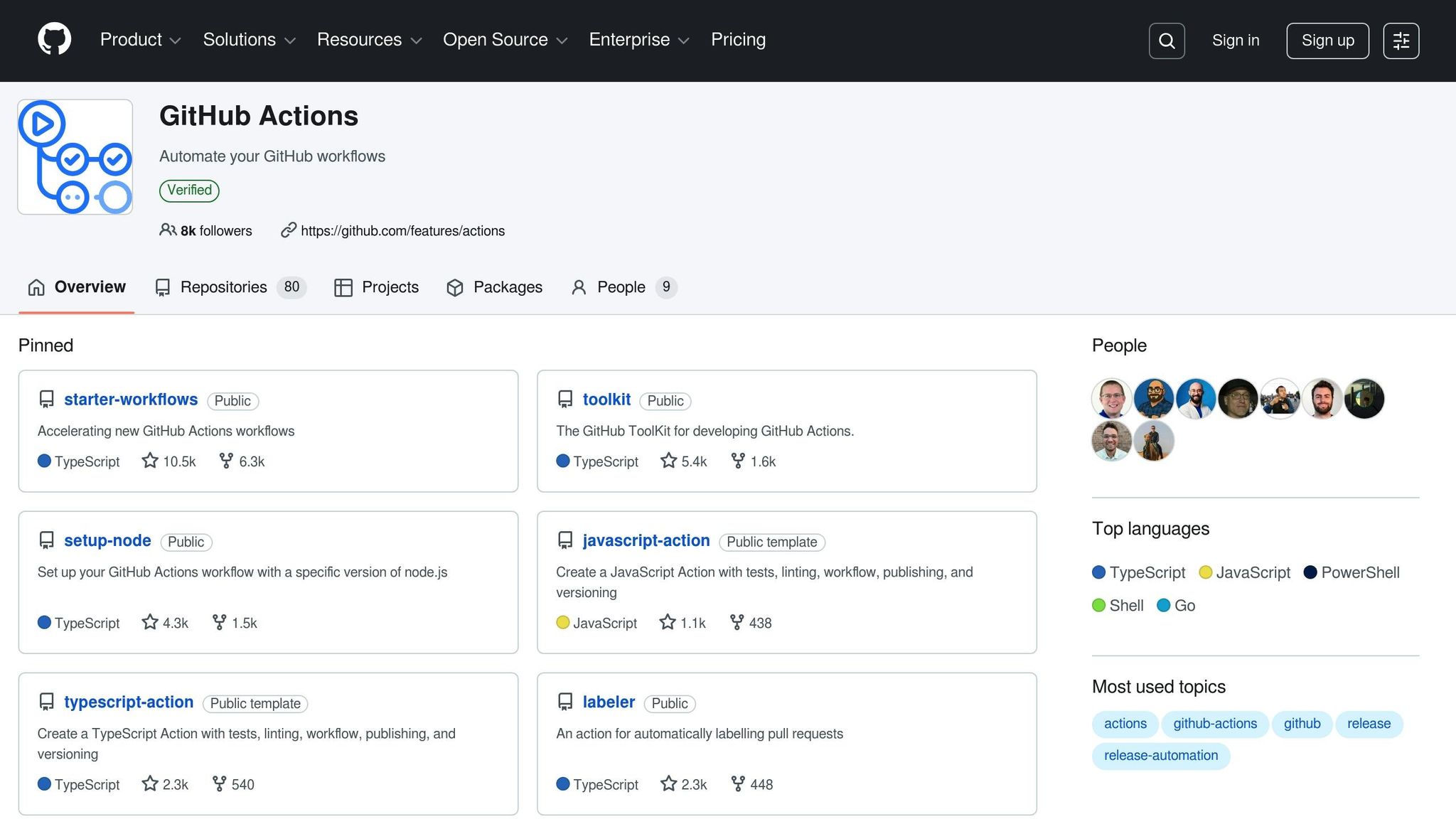
1. Pynt
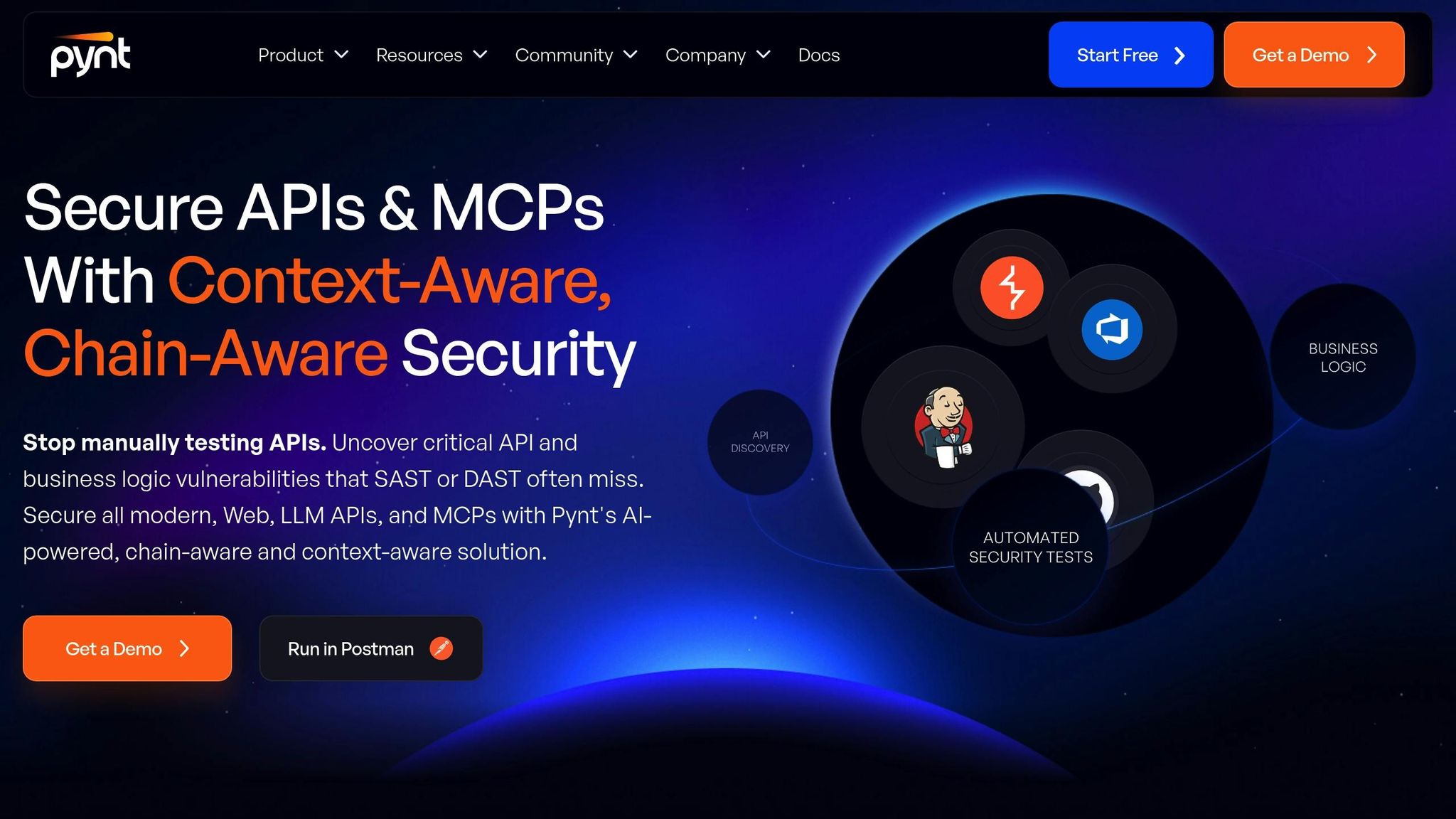
Pynt is a tool designed to test API security by automating vulnerability detection during the development phase. Instead of waiting until production to uncover potential risks, Pynt identifies flaws early on, which is particularly useful for UK organisations adhering to strict data protection laws. This early detection aligns perfectly with the CI/CD principle of catching issues as soon as possible.
Integration with CI/CD workflows
Pynt fits effortlessly into CI/CD workflows, working with Jenkins, GitLab CI, GitHub Actions, and more. It operates through a lightweight Docker container that integrates directly into your pipeline. Once set up, Pynt automatically runs security scans whenever new code is committed, ensuring every API endpoint is thoroughly checked for vulnerabilities before reaching production.
The tool's RESTful API allows teams to customise scanning parameters and merge results with existing dashboards, making it easy to align security findings with other build metrics.
Coverage of vulnerabilities
Pynt focuses on identifying API vulnerabilities and addresses the OWASP API Security Top 10. It detects issues like injection attacks, broken authentication, excessive data exposure, and weak asset management. By using dynamic testing, Pynt can spot runtime vulnerabilities that static analysis tools might miss.
The platform performs behavioural analysis on API responses, flagging unusual patterns that could signal security gaps. For instance, it can detect when APIs reveal more data than necessary. Additionally, Pynt identifies problems like rate-limiting failures and authentication bypass vulnerabilities, both of which could lead to serious data breaches.
Automation and real-time detection capabilities
Pynt streamlines the testing process by automatically generating test cases based on API specifications. This reduces the manual workload for security teams while ensuring thorough coverage of all API endpoints, regardless of team size or expertise.
With real-time feedback, Pynt provides scan results within minutes, helping developers address issues promptly. When vulnerabilities are uncovered, the tool offers detailed, language-specific guidance on how to fix them. This means developers can resolve problems quickly, even without deep security expertise.
2. OWASP ZAP
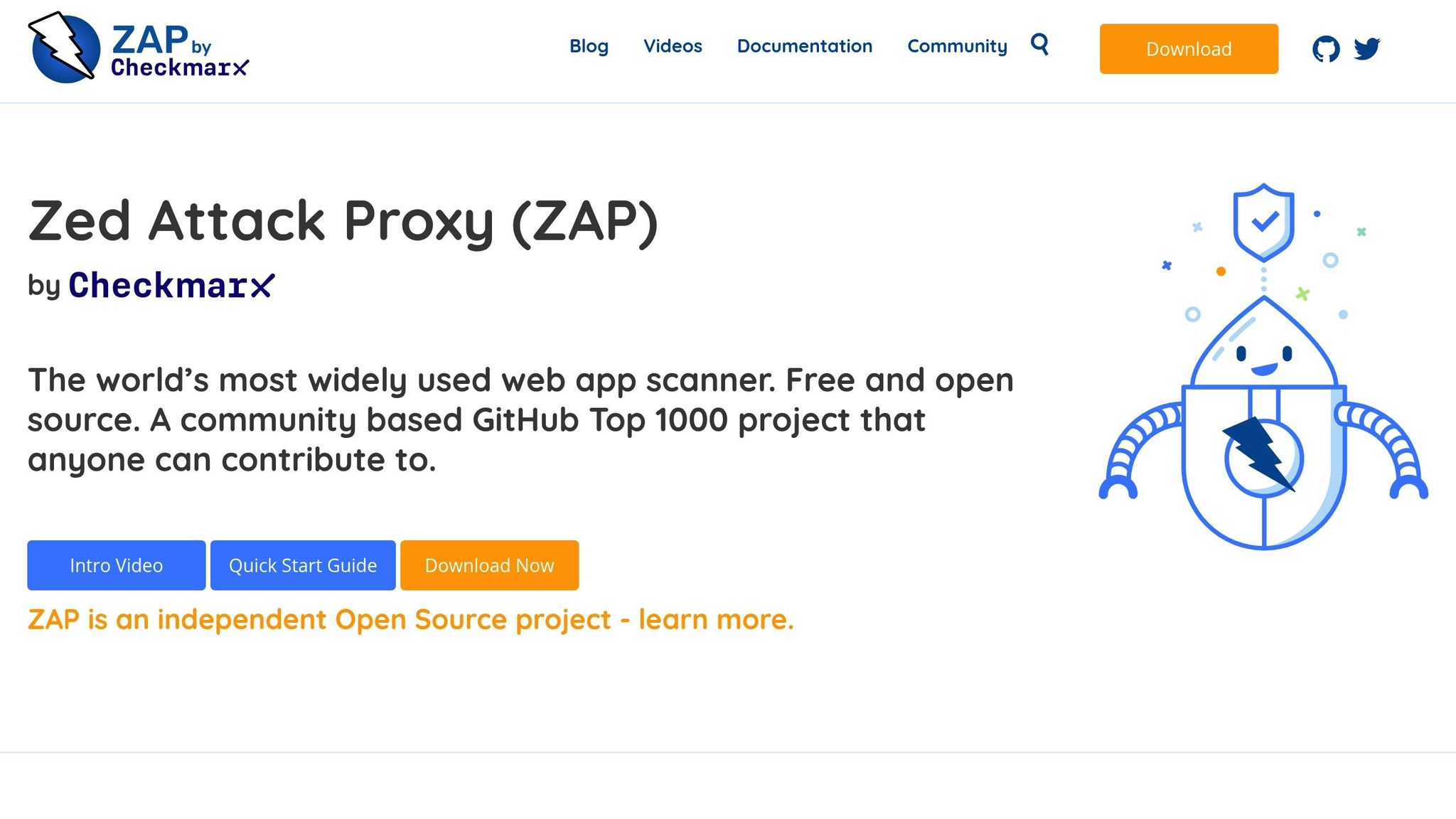
OWASP ZAP (Zed Attack Proxy) is an open-source web scanner that offers a powerful way to detect vulnerabilities in CI/CD pipelines - all without any licensing fees. For organisations in the UK working with limited security budgets, this tool provides a cost-effective solution.
Integration with CI/CD Workflows
ZAP fits effortlessly into CI/CD pipelines thanks to its command-line interface (CLI), Docker compatibility, and REST API. It works well with popular tools like Jenkins, GitLab CI, GitHub Actions, and Azure DevOps. This allows teams to perform quick baseline scans during development and more thorough scans in staging environments.
According to UK-based security experts at Hokstad Consulting, ZAP is a reliable choice for continuous vulnerability assessment, offering dependable results throughout the development lifecycle.
Coverage of Vulnerabilities
ZAP is designed to address critical vulnerabilities highlighted in the OWASP Top 10, such as injection flaws, broken authentication, security misconfigurations, and cross-site scripting (XSS). Its spidering feature automatically maps out application endpoints, ensuring thorough scanning - even in complex systems. Additionally, ZAP’s fuzzing capabilities are particularly useful for identifying input validation issues that might otherwise go unnoticed.
Compliance with UK-Specific Regulations
Beyond helping to secure applications, ZAP plays a role in meeting legal obligations. For example, it assists UK organisations in working towards GDPR compliance by identifying vulnerabilities that could lead to data breaches, helping protect sensitive user data.
Automation and Real-Time Detection
ZAP’s scripting engine supports JavaScript, Python, and Zest, allowing teams to customise tests to their specific needs. It also offers real-time alerts and the option to schedule scans, ensuring new vulnerabilities are caught as soon as they emerge. This makes it a practical choice for organisations aiming to maintain strong, proactive security practices.
3. Trivy
Trivy is a powerful open-source security scanner developed by Aqua Security. It’s designed to pinpoint vulnerabilities across a wide range of targets with impressive speed. What makes Trivy stand out is how well it fits into CI/CD workflows, allowing teams to detect issues early in the development process. This proactive approach helps identify vulnerabilities and Infrastructure as Code (IaC) flaws before they become bigger problems down the line [1][2][3].
Integration with CI/CD Workflows
Trivy works smoothly within CI/CD pipelines, making it easier to catch and address vulnerabilities during development rather than after deployment. This early detection reduces risks and saves time in the long run.
Coverage of Vulnerabilities
From application components to infrastructure, Trivy scans thoroughly to uncover potential weak points. By doing so, it gives teams the tools they need to address security concerns before they escalate.
4. Clair
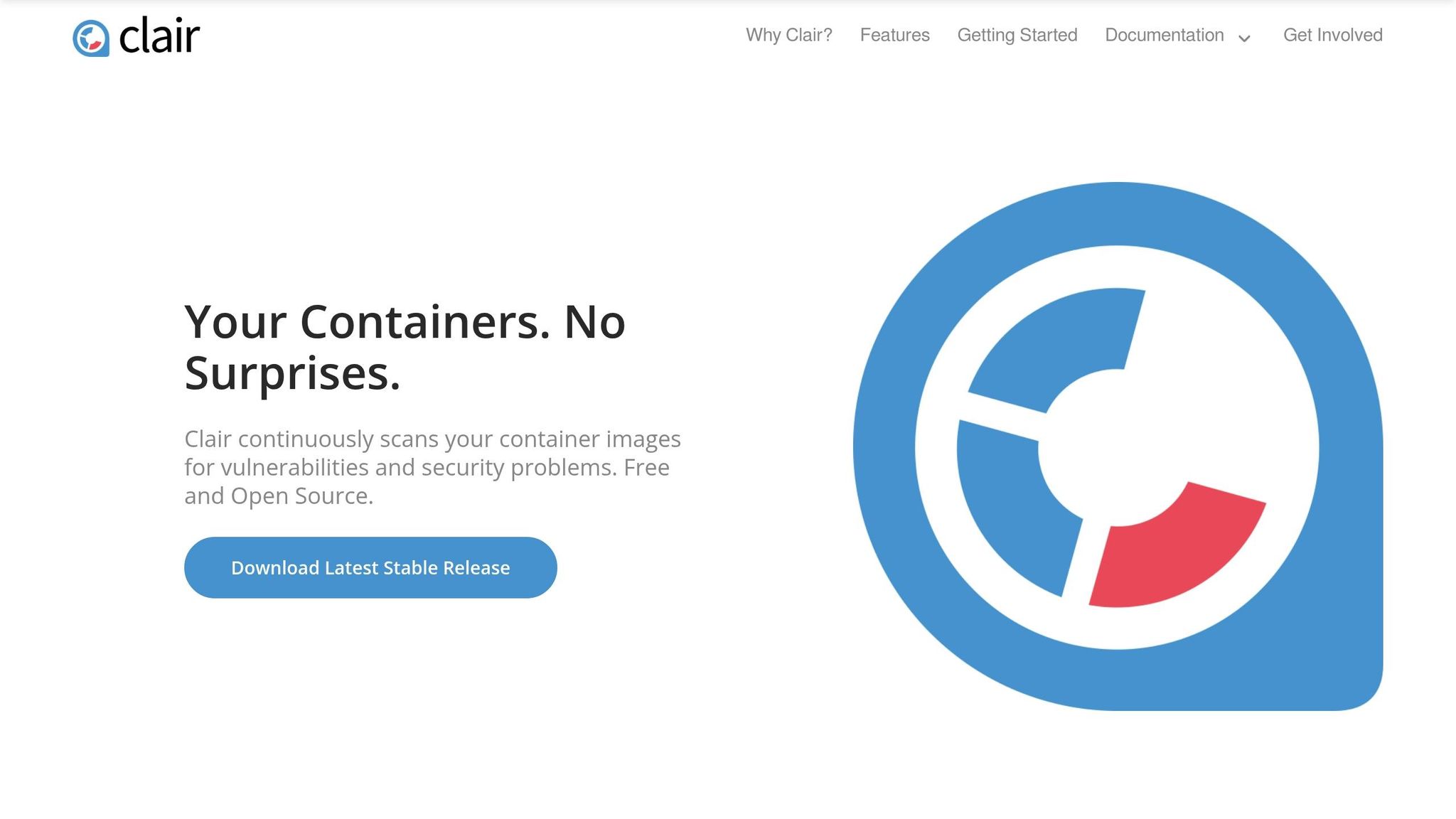
Clair is an open-source tool designed specifically to scan for vulnerabilities in container environments. Originally developed by CoreOS (now part of Red Hat), Clair focuses on analysing container images to uncover known security issues within their layers. Unlike more generalised security tools, Clair zeroes in on the container ecosystem, making it a go-to option for organisations deeply invested in containerised applications and microservices. This targeted approach complements broader vulnerability scanning tools.
Integration with CI/CD Workflows
Clair's design allows it to fit seamlessly into CI/CD workflows, thanks to its API-driven architecture. It automatically scans container images during the build process, helping to block vulnerable containers from advancing to production. Many teams pair Clair with container registries like Docker Hub or Amazon ECR, ensuring that every image uploaded undergoes a thorough security check.
The tool works by comparing the contents of container layers against regularly updated vulnerability databases from major Linux distributions such as Ubuntu, Red Hat, Debian, and Alpine. This proactive scanning helps teams identify and address security issues early in the development cycle, rather than after deployment.
Coverage of Vulnerabilities
One of Clair's strengths is its focus on operating system vulnerabilities within container images. It inspects each layer of a container, identifies installed packages, and cross-references them with CVE databases from major Linux distributions and package managers like APT, YUM, and APK. This detailed analysis equips teams to take preventative action during the build process.
While Clair excels at identifying OS-level vulnerabilities, it doesn't address application-specific security risks. Teams often use Clair alongside other tools that specialise in analysing application code to ensure comprehensive security coverage.
Automation and Real-Time Detection Capabilities
Clair provides continuous monitoring for indexed container images. Whenever new vulnerability data becomes available, Clair automatically rescans images, maintaining an up-to-date security profile.
The tool generates detailed vulnerability reports, including severity levels, affected package versions, and available fixes. This helps development teams prioritise their response based on the level of risk. Additionally, Clair can be configured to send automated alerts for high-severity vulnerabilities, enabling teams to act quickly and efficiently.
Need help optimizing your cloud costs?
Get expert advice on how to reduce your cloud expenses without sacrificing performance.
5. Invicti DAST
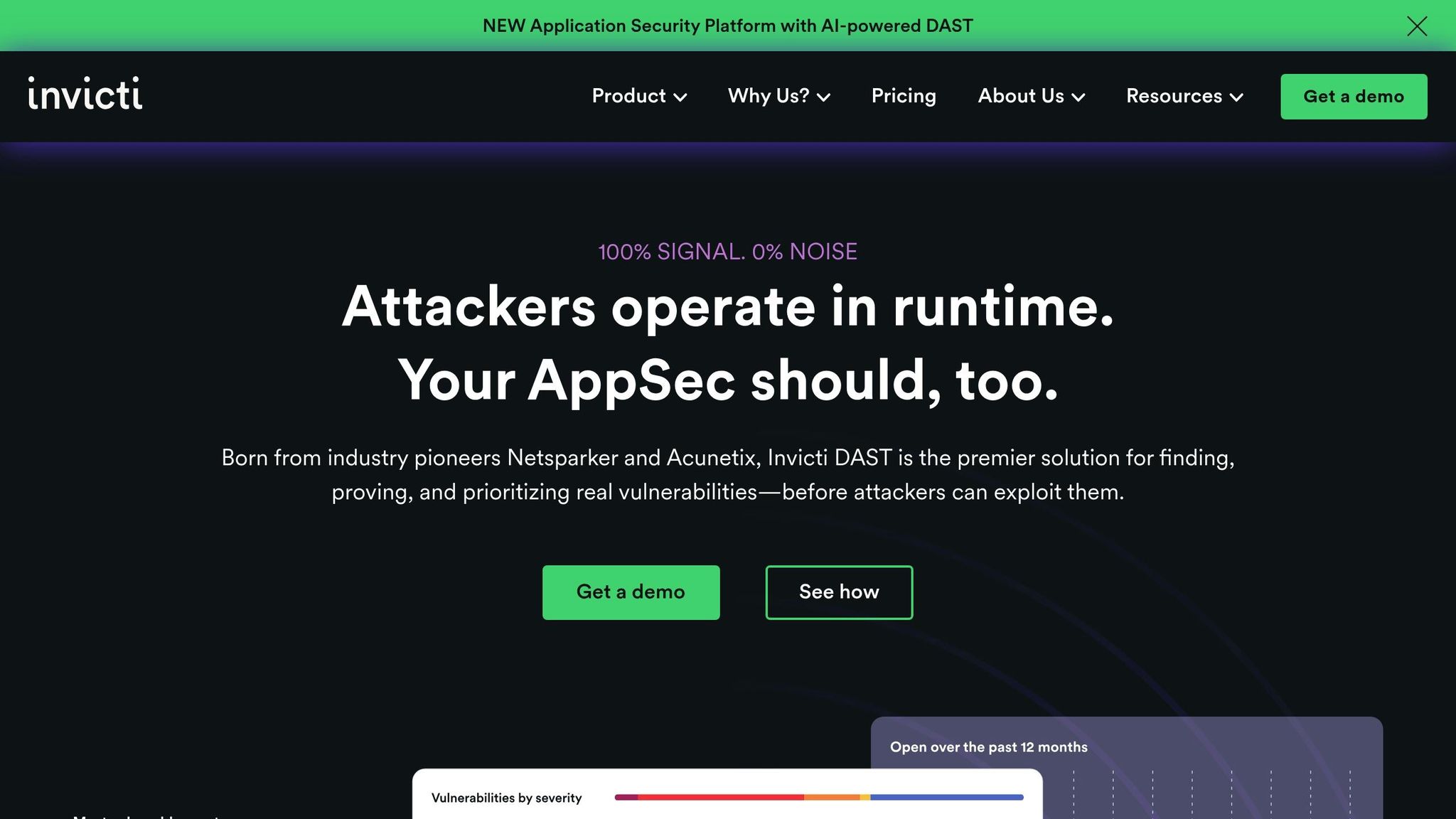
Invicti DAST is a web application security scanner designed to uncover vulnerabilities in live applications by simulating actual attack scenarios. Unlike static analysis tools that only review code in a dormant state, Invicti DAST interacts with applications as they function, identifying issues that arise during runtime. This makes it particularly effective at spotting vulnerabilities caused by the way components interact.
Integration with CI/CD Workflows
Invicti DAST integrates seamlessly into CI/CD pipelines through its REST API and CLI. This allows development teams to automate scans at key stages of the deployment process, such as after pushing to a staging environment or just before a production release. The tool is compatible with widely used CI/CD platforms like Jenkins, Azure DevOps, and GitLab CI, enabling teams to incorporate security testing directly into their existing workflows.
Teams can optimise efficiency by setting up incremental scans for modified areas or running full scans for major releases. This flexibility ensures thorough vulnerability checks without slowing down the deployment process.
Coverage of Vulnerabilities
The tool is equipped to detect a wide range of vulnerabilities, including SQL injection, cross-site scripting (XSS), authentication bypasses, and business logic flaws. Its advanced crawler technology can navigate even the most complex web applications, such as single-page applications (SPAs) and those heavily reliant on JavaScript frameworks like React and Angular.
Invicti DAST also excels in API security testing, automatically discovering and testing REST, SOAP, and GraphQL endpoints. It can parse OpenAPI specifications and Postman collections to ensure thorough coverage of APIs. This is especially critical for organisations adopting microservices architectures, where securing APIs is a high priority.
Additionally, Invicti DAST supports authentication-based testing, enabling it to scan protected areas of applications that require user login. It handles complex authentication setups, including multi-factor authentication and OAuth, ensuring no part of the application is left unchecked.
Compliance with UK-Specific Regulations
The tool also helps organisations meet regulatory requirements. Invicti DAST supports compliance with GDPR and PCI DSS by identifying vulnerabilities that could lead to data breaches or compromise payment information, helping businesses maintain adherence to UK-specific regulations.
Automation and Real-Time Detection Capabilities
With its Proof-Based Scanning feature, Invicti DAST minimises false positives and provides instant alerts through email, Slack, or JIRA when critical vulnerabilities are identified. These alerts come with detailed remediation guidance, making it easier for developers to address issues promptly.
The tool also offers continuous monitoring for production environments, running lightweight scans to detect emerging vulnerabilities. Its reports are clear and actionable, helping teams prioritise and resolve security gaps efficiently.
6. Nessus
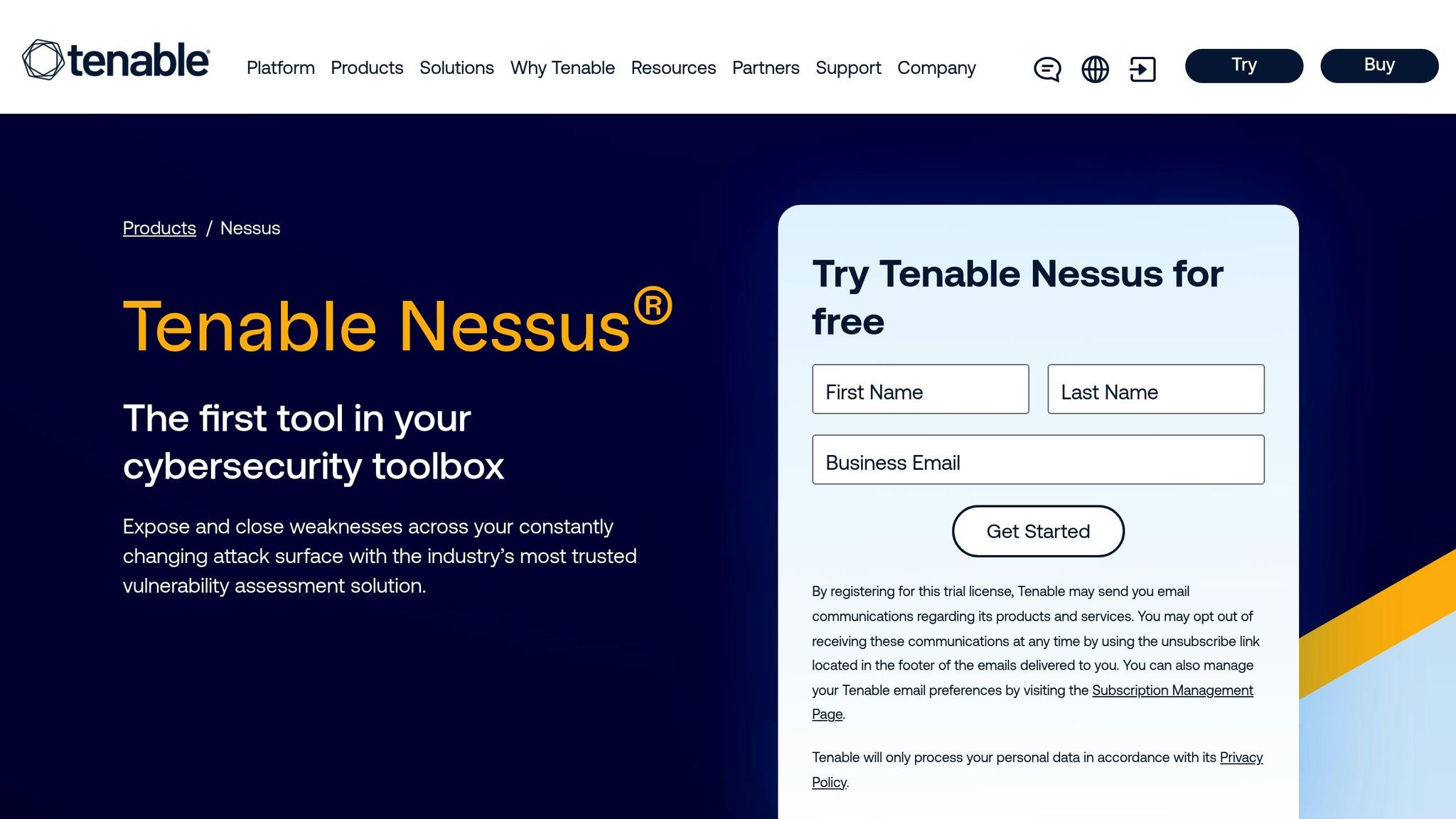
Nessus is a widely recognised vulnerability scanner initially designed for network security but has since adapted to meet the needs of modern DevOps practices. By integrating with CI/CD pipelines through its API and CLI, Nessus allows teams to schedule vulnerability scans at key stages, such as pre-deployment checks in staging environments. Additionally, it supports custom scripts and plugins to work seamlessly with tools like Jenkins, GitLab CI, and Azure DevOps. This integration ensures that security checks are embedded consistently throughout the development lifecycle.
Coverage of Vulnerabilities
Nessus conducts a broad range of vulnerability checks, covering everything from operating system flaws to common web application vulnerabilities like SQL injection and cross-site scripting. Its credentialed scanning goes deeper by analysing system configurations and installed software, providing more precise results - especially valuable for teams working in fast-paced development environments.
Compliance and Reporting
Beyond identifying vulnerabilities, Nessus helps organisations meet compliance requirements. It includes compliance scanning features that highlight configuration issues and assist with adhering to standards like PCI DSS. Its detailed reports simplify tracking vulnerabilities and documenting fixes, which is particularly useful during audits.
Automation and Real-Time Updates
Nessus relies on an actively updated plugin feed to identify the latest vulnerabilities. With automated alerts and customisable dashboards, teams can monitor their security status closely and act quickly when critical issues arise. This real-time tracking supports the continuous security demands of modern CI/CD workflows.
7. SentinelOne CI/CD Security Suite
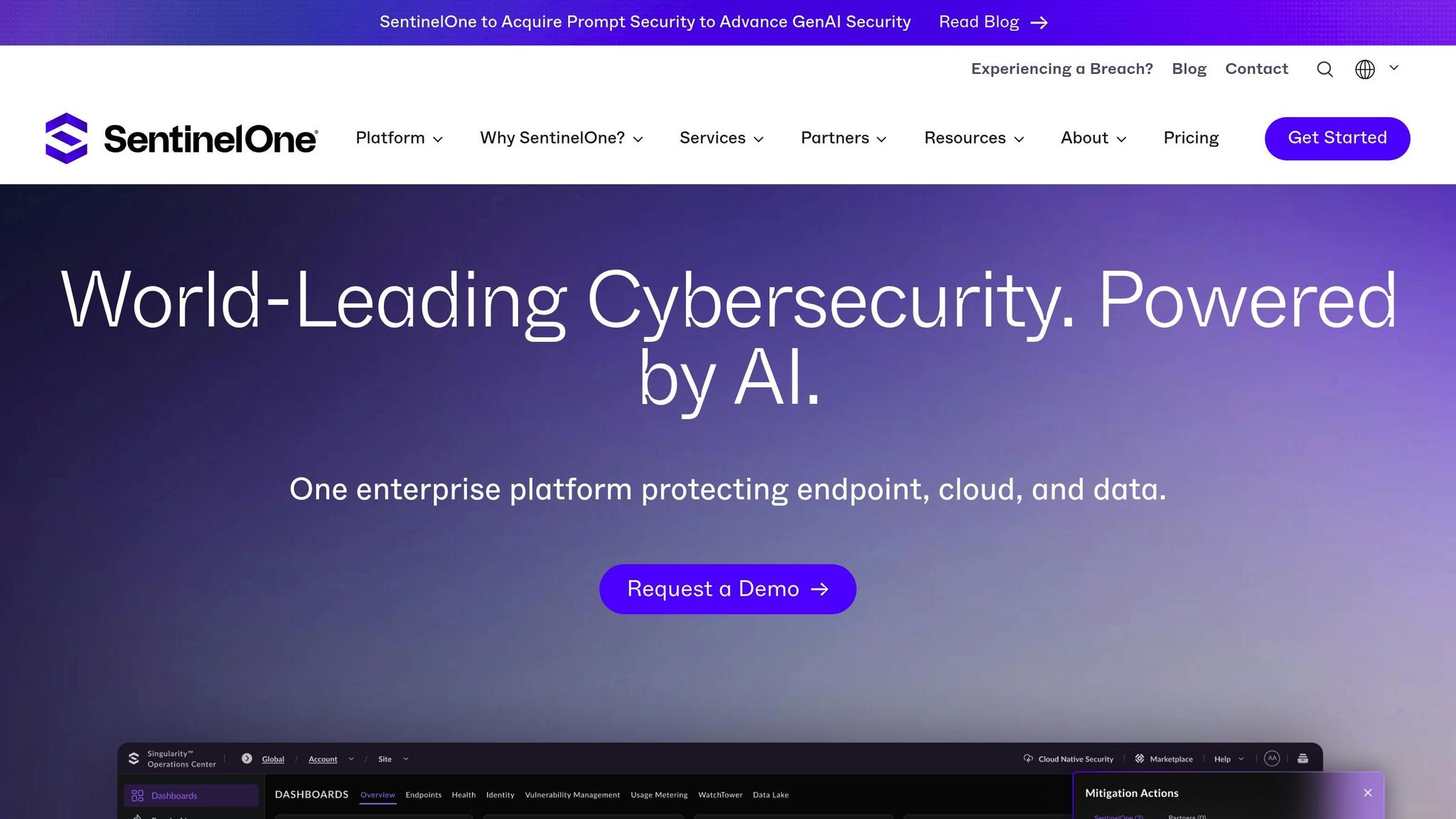
SentinelOne's CI/CD Security Suite brings security directly into the heart of CI/CD environments, safeguarding every step of the development process. This tool underscores the importance of building security into the entire CI/CD pipeline from start to finish.
Integration with CI/CD Workflows
This suite seamlessly integrates with typical CI/CD build and deployment workflows, embedding security checks at each stage. Instead of focusing on just one type of vulnerability, SentinelOne ensures comprehensive security by placing validation points throughout the pipeline. This approach keeps delivery efficient while maintaining a strong security framework.
Vulnerability Detection and Remediation
SentinelOne goes beyond basic vulnerability scanning by offering actionable remediation guidance. It scans container images and code dependencies for potential risks and provides clear steps to address them. This ensures that issues can be resolved quickly and effectively, reducing downtime and maintaining workflow momentum.
Automation and Real-Time Monitoring
One of the suite's standout features is its ability to automate continuous security monitoring. It identifies and addresses new vulnerabilities as they arise, all in real time. This proactive approach ensures that the CI/CD pipeline remains secure, meeting the fast-paced demands of modern development without compromising on safety.
Tool Comparison Table
When selecting a CI/CD vulnerability tool, it's important to strike a balance between functionality and budget. Here's a quick look at how various tools compare in terms of pricing:
| Tool | Type | Pricing (GBP) |
|---|---|---|
| Pynt | Commercial | Free starter option; full pricing available on request |
| OWASP ZAP | Open Source | Free |
| Trivy | Open Source | Free (enterprise support available via Aqua Security) |
| Clair | Open Source | Free |
| Invicti DAST | Commercial | Entry-level pricing is higher; pricing on request |
| Nessus | Commercial | Pricing on request |
| SentinelOne | Commercial | Enterprise pricing on request |
This table highlights the pricing structure for each tool, helping you make an informed choice.
Looking at the options, there's a clear divide between open-source and commercial tools. If you're working with a tight budget, OWASP ZAP, Trivy, and Clair provide effective, no-cost solutions for vulnerability detection. On the other hand, commercial tools like Invicti DAST, Nessus, SentinelOne, and Pynt cater to enterprise-level needs, often requiring custom pricing for advanced features.
Conclusion
Choosing the right CI/CD vulnerability detection tool is a critical step in safeguarding your development pipeline, especially with cyber threats becoming more sophisticated. Regulatory requirements, like GDPR, further emphasise the need for robust data protection measures. The tools discussed in this guide offer diverse solutions to help meet these challenges.
The decision often comes down to balancing costs and capabilities. Open-source tools such as OWASP ZAP, Trivy, and Clair are excellent choices for teams on a tight budget or those just starting out. These tools provide effective vulnerability detection without upfront expenses, making them particularly appealing for startups and smaller organisations.
On the other hand, enterprise-grade solutions like Invicti DAST, Nessus, SentinelOne, and Pynt offer advanced features, comprehensive support, and in-depth reporting. While these tools require a greater financial investment, they often deliver significant benefits, such as fewer security incidents, quicker response times, and enhanced compliance with regulations.
When selecting a tool, consider how well it aligns with your CI/CD infrastructure, your team’s skill level, compliance requirements, and budget. For instance, a financial services firm in London may prioritise compliance and reporting, while a Manchester-based e-commerce startup might focus on scalability and ease of use.
Integration with your existing DevOps workflow is also key. Modern cloud environments demand tools that can scale seamlessly while maintaining consistent security across your infrastructure.
For organisations looking to refine their DevOps security strategy, working with experts like Hokstad Consulting can be invaluable. They can assist with tool selection, implementation, and ongoing security improvements, ensuring your security measures align with broader cloud infrastructure goals.
Each tool in this guide has its own strengths, but the real value lies in how effectively you address vulnerabilities and prevent future issues. By choosing the right solution, you can strengthen your pipeline and protect your organisation against evolving threats.
FAQs
What should I consider when selecting the right CI/CD vulnerability detection tool for my organisation?
To pick the right CI/CD vulnerability detection tool for your organisation, begin by pinpointing your key requirements. Think about factors like how well it integrates with your current pipeline, its ability to scale as you grow, and the level of automation it offers. The tool should be capable of spotting vulnerabilities early in the development cycle and should align with your organisation's security standards.
When assessing options, check how compatible they are with your existing technology stack and how effectively they support your DevOps processes. Look for tools that embed security checks seamlessly into your workflow, ensuring they don't interrupt deployment cycles while keeping your pipeline secure and efficient.
What are the main differences between open-source and commercial CI/CD vulnerability detection tools?
Open-source CI/CD vulnerability detection tools are a popular choice for teams with strong technical skills. They’re usually free and allow for a high level of customisation, thanks to the support of a dedicated developer community. That said, they often fall short when it comes to features like detailed compliance reporting, enterprise-level dashboards, and smooth integrations with other systems.
On the other hand, commercial tools are built with enterprise environments in mind. They offer dedicated support, enhanced security, and features like real-time monitoring, automated compliance checks, and the ability to scale for larger teams. However, these benefits come at a price, as they typically require licensing fees or subscriptions, which can add up depending on your organisation's size.
Ultimately, the decision between open-source and commercial tools boils down to your team’s technical expertise, budget, and specific requirements.
How can CI/CD vulnerability detection tools help my organisation meet UK regulations like GDPR?
CI/CD vulnerability detection tools are essential for UK organisations aiming to adhere to GDPR regulations. These tools work by pinpointing and addressing security weaknesses throughout the software development lifecycle, offering real-time scanning within CI/CD pipelines. This ensures that sensitive personal data is protected and managed according to GDPR's stringent data security standards.
By automating vulnerability checks and producing compliance reports, these tools help organisations stay consistently aligned with GDPR requirements. They minimise the chances of data breaches, reduce the risk of penalties, and demonstrate a commitment to accountability. Beyond avoiding fines, this proactive strategy strengthens trust with both customers and regulators.
